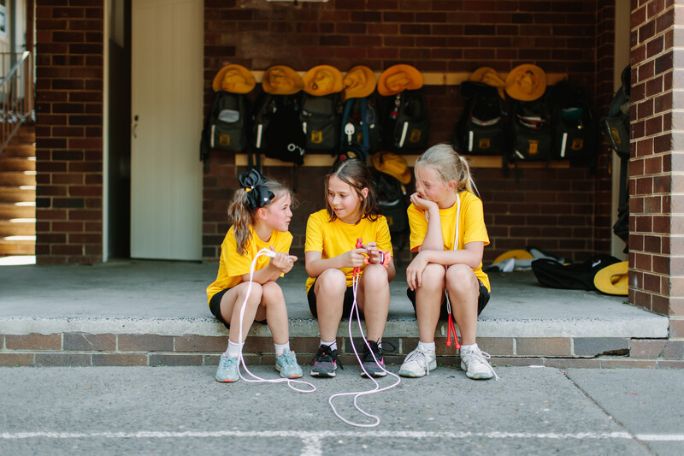Lesson summary
In this lesson, students explore giving and receiving directions. They will learn to perform intricate partner skipping techniques, requiring strong verbal communication skills and trust in one another.
Learning intentions:
Students will...
- develop an awareness of their bodies, gross motor skills and rhythm
- build confidence in skipping equipment and processes.
Success criteria:
Students can...
- give and receive clear and specific instructions
- perform a variety of fundamental movement skills and movement sequences, including different skipping techniques.
Lesson guides and printables
Curriculum links
Select your curriculum from the options below.
Lesson details
Curriculum mapping
Australian Curriculum content descriptions:
Year 3 English:
- Understand that successful cooperation with others depends on shared use of social conventions, including turn-taking patterns, and forms of address that vary according to the degree of formality in social situations (ACELA1476)
- Understand that verbs represent different processes, for example, doing, thinking, saying and relating and that these processes are anchored in time through tense (ACELA1482)
- Use interaction skills, including active listening behaviours and communicate in a clear, coherent manner using a variety of everyday and learned vocabulary and appropriate tone, pace, pitch and volume (ACELY1792)
Year 4 English:
- Use interaction skills such as acknowledging another’s point of view and linking students’ response to the topic, using familiar and new vocabulary and a range of vocal effects such as tone, pace, pitch and volume to speak clearly and coherently (ACELY1688)
Years 3 & 4 Health and Physical Education:
- Practise and refine fundamental movement skills in a variety of movement sequences and situations (ACPMP043)
- Practise and apply movement concepts and strategies with and without equipment (ACPMP045)
- Combine elements of effort, space, time, objects and people when performing movement sequences (ACPMP047)
- Apply innovative and creative thinking in solving movement challenges (ACPMP049)
Syllabus outcomes: EN2-1A, EN2-9B, MOS2.4, GSS2.8, GYS2.10
General capabilities: Critical and Creative Thinking, Personal and Social Capability
Relevant parts of the Year 3 English achievement standards: Students understand how language features, images and vocabulary choices are used for different effects. They listen to others’ views and respond appropriately using interaction skills. They understand how language features are used to link and sequence ideas.
Relevant parts of the Year 4 English achievement standards: Students use language features to create coherence and add detail to their texts
Relevant parts of the Year 3 – 4 Health and Physical Education achievement standards: Students apply strategies for working cooperatively. They refine fundamental movement skills and apply movement concepts and strategies in a variety of physical activities and to solve movement challenges. They create and perform movement sequences using fundamental movement skills and the elements of movement.
This lesson is part of the wider unit of work Jump Rope For Heart: Jump Investigators – Years 3 & 4
Time required: 45 mins
Level of teacher scaffolding: Low – scaffold students independently exploring new skipping techniques
Resources required
- Blindfolds or long strips of material (or students can just close their eyes)
- Device capable of presenting a video to the class
- Hula hoops – one for each group of four students
- Long skipping ropes – one for each group of four students
- Short skipping ropes – one per student
Skills
This lesson is designed to build students’ competencies in the following skills:
- Communication
- Creativity
- Adaptability
- Leadership
- Problem solving
- Social skills
- Collaboration
Additional info
The Heart Foundation’s ready-made skipping program, Jump Rope for Heart, helps primary school students move more and have fun, while they raise funds for heart research, patient support and programs that help save lives.


Welcome back!
Don't have an account yet?
Log in with:
Create your free Cool.org account.
Many of our resources are free, with an option to upgrade to Cool+ for premium content.
Already have an account?
Sign up with:
By signing up you accept Cool.org's Terms and Conditions(Opens in new tab) and Privacy Policy(Opens in new tab).